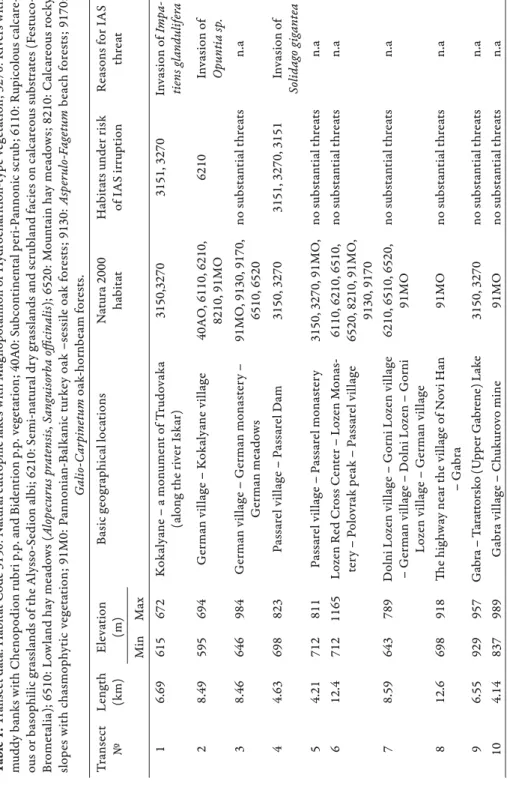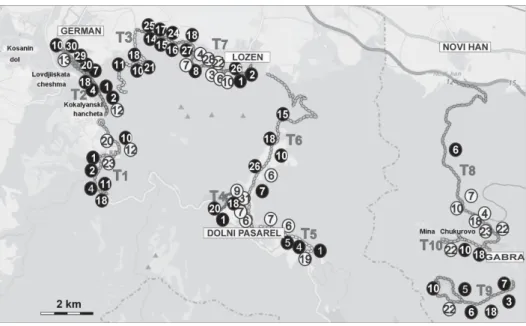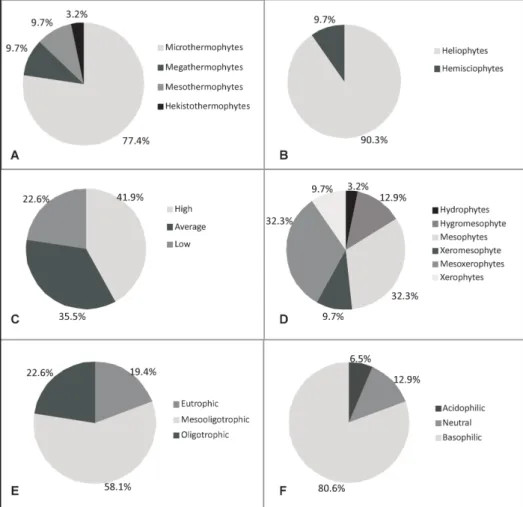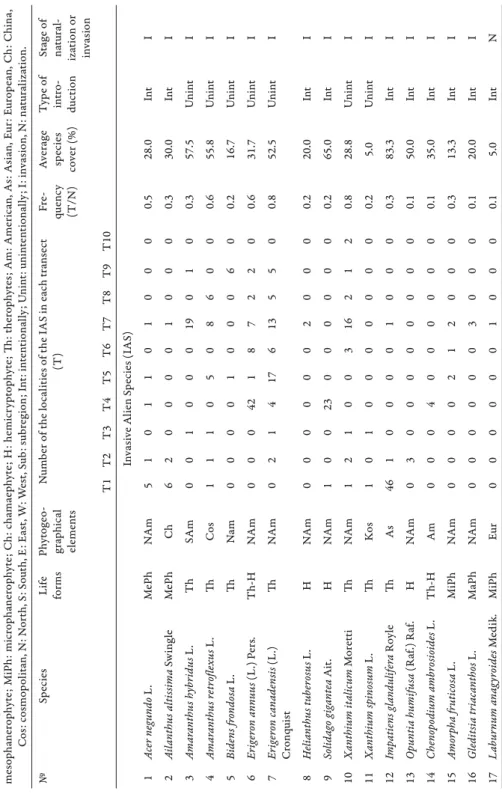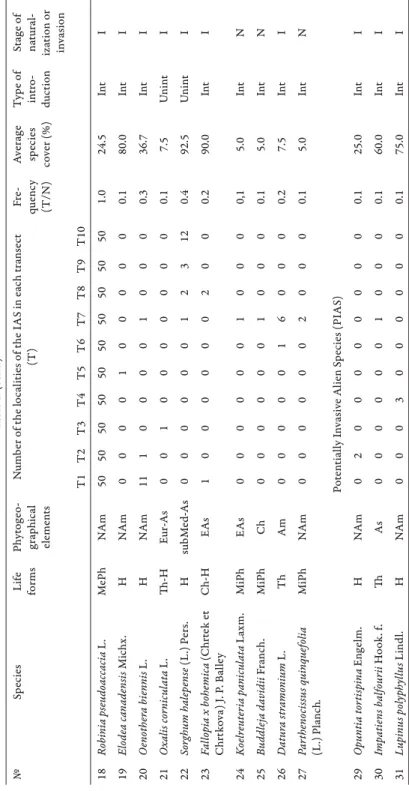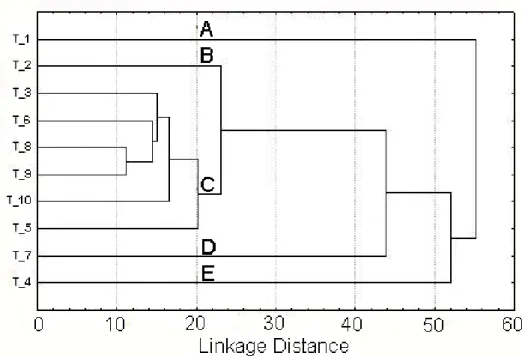DOI: 10.17716/BotKozlem.2019.106.2.197
Survey of invasive alien species in the fl ora of Lozenska Mountain, Bulgaria
Plamen GLOGOV1*, Dolja PAVLOVA2, Mira GEORGIEVA3, Yonko DODEV1 and Stela GYUDOROVA1
1Department of Silviculture, Forest Research Institute, Bulgarian Academy of Sciences, 132 St. Kliment Ohridski Blvd., 1756 Sofi a, Bulgaria;
pglogov@abv.bg, ionkododev@abv.bg, stella_gjudorova@abv.bg
2Department of Botany, Faculty of Biology, University of Sofi a, 8 Dragan Tzankov Blvd., 1164 Sofi a, Bulgaria; dolja_pavlova@abv.bg
3Department of Forest Genetics, Physiology and Plantations, Forest Research Institute, Bulgarian Academy of Sciences, 132 St. Kliment Ohridski Blvd., 1756 Sofi a, Bulgaria;
mirageorgieva@abv.bg Accepted: 1 August 2019
Key words: abundance, distribution, ecological strategy, frequency, invasive plants.
Abstract: Th is study explores the invasive alien fl ora of Lozenska Mountain, southwestern Bulgaria (maximum height 1190 m, area 80 km2). Th e aims were to (i) describe the taxonomic and ecological structure of the invasive alien fl ora in Lozenska Mountain, and (ii) provide data on the local dis- tribution of the globally most widespread invasive species. Ten transects of diff erent lengths (from 4 to 12 km) in diff erent parts of the mountain covering the most characteristic habitats were sur- veyed between April 2017 and October 2018. Altogether, 27 invasive alien species (IAS) and 4 po- tentially invasive alien species (PIAS) belonging to 17 families of fl owering plants were encountered.
Th ese represent 3.46% of the fl ora of Lozenska Mountain, and 45% of all the IAS in Bulgaria. Seven species (Acer negundo, Ailanthus altissima, Amorpha fr uticosa, Bidens fr ondosus, Fallopia × bohe mica, Opuntia humifusa and Robinia pseudoacacia) are highly aggressive. In the biological spectrum of IAS, therophytes predominate (29%), followed by hemicryptophytes (19.4%). Th e majority of IAS originates from America (65.6%) and Asia (19.5%). 64.5% of the IAS were deliberately introduced.
Th e established invasive species on the territory of the mountain are predominantly heliophytes (90.3%); microthermophytes (71.0%); high humidity species (38.7%); mesophytes (54.8%), mesoo- ligotrophs (58.1%) and basophilic species (80.6%).
Th e most widespread species are Robinia pseudoacacia, Erigeron canadensis and Xanthium italicum.
Most of the IAS were found in one transect only. Th e highest percentage of species cover (over 80%) was reached by plants adapted to specifi c habitats: aquatic (Elodea canadensis), riparian (Impatiens glan dulifera, Fallopia × bohemica) and anthropogenically heavily disturbed terrains (Sorghum hale- pen se). Th ere is a substantial threat of IAS irruption on the territory of Lozenska Mountain for the following habitat types (reference codes according to Annex I of the Directive 92/43/EEC): 3150 (Natural eutrophic lakes with Magnopotamion or Hydrocharition vegetation) and 3270 (Rivers with muddy banks with Chenopodion rubri p.p. and Bidention p.p. vegetation) included in Natura 2000.
* Corresponding author
A map of IAS occurrences in the mountain was prepared and it was found that IAS predominantly appear in areas around rivers with permanent water regime such as Iskar, Rakita and Gabra, and near urbanized areas adjacent to settlements, along roads and in abandoned mines. Th e popula- tions of the species Amaranthus hybridus, A. retrofl exus, Elodea canadensis, Erigeron annuus, E. ca- nadensis, Fallopia × bohemica, Impatiens glandulifera, Oenothera biennis, Opuntia humifusa, Robinia pseudoacacia, Solidago gigantea, Sorghum halepense and Xanthium italicum occur in certain parts of Lozenska Mountain. Other IAS have so far formed small populations only being accessorial ele- ments in natural plant communities.
Introduction
Th e problem with the spread of Invasive Alien Species (IAS) is global in scope and requires international cooperation to supplement the actions of gov- ernments, economic sectors and individuals at national and local levels. Th ese species are causing enormous damage to biodiversity and the valuable natural ag- ricultural systems upon which we depend (McNeely et al. 2001). IAS are includ- ed in the National Biodiversity Conservation Strategy of Bulgaria (formulated in 1998) as one of the threats to the biodiversity of the country. Th e Biodiversity Strategy 2020 of the European Union (EU) requires detailed information about the distribution of these species as a step towards their isolation, elimination and control over their introduction. In addition, regular studies on the IAS composi- tion and distribution are essential to track the dynamics of the alien fl ora on the territory of the country (Petrova and Vladimirov 2007, 2012).
Th e project Delivering Alien Invasive Species Inventories for Europe (DAISIE 2009) funded by the European Union led to the compilation and update of alien plant species inventories for many countries such as Serbia (Lazarević et al. 2012), Romania (Sîrbu and Oprea 2011), Czech republic (Pyšek et al.
2012), Slovakia (Medvecká et al. 2012), Montenegro (Stešević and Petrović 2010). A list of invasive alien species in Bulgaria was prepared and edited by Petrova et al. (2013). It summarized regional data for the chorology of new alien species found on the territory of Bulgaria and for well-known ones already included in the volumes of Flora of the Republic of Bulgaria. Recently, surveys of the invasive alien fl ora for local regions in Bulgaria were conducted (Asenov and Dimitrov 2013, Aneva et al. 2018). An updated chorological information about the alien species distributed in Bulgaria was also provided (Kalníková and Palpurina 2015, Petrova 2017). Only complete lists of alien species, pre- sented for separate regions, can provide a robust basis for analyses of regional lev- els of invasions and underlying driving forces (Pyšek et al. 2018, Vinogradova et al. 2018). Such analyses are important not only for a better understanding of the factors determining local invasions, but also for obtaining a more complete
picture of global alien species richness (van Kleunen et al. 2015, Pyšek et al.
2017, Vinogradova et al. 2018).
Because of its proximity to the capital and great economic and recreational potential, Lozenska Mountain is subject to a strong anthropogenic impact. As a result, a number of degradation processes are taking place on its territory which reduce the autochthonous vegetation and open niches for new species, including invasive ones. Part of the mountain territory (14.3%) is included in Natura 2000, and falls under special management regimes that require the identifi cation of potential threats for the habitats. Glogov and Delkov (2016) have recorded 11 IAS (1.26% of the whole fl oristical composition of the mountain) during their fl oristic survey on the territory of Lozenska Mountain. Th e present study is fo- cused on the IAS of Lozenska Mountain and constitutes part of the ongoing in- ventory of the invasive plant species distributed on the territory of the country. It is accepted that an “alien species” is a species occurring outside its natural distri- bution while an “invasive alien species” is an exotic species which becomes estab- lished with high abundance in natural or semi-natural habitats. Such plants are agents of change and threaten native biological diversity (Williamson 1996, IUCN 2000, Shine et al. 2000, McNeely et al. 2001).
Th e aims of this study are to (1) provide a list of invasive alien plant species on the territory of Lozenska Mountain, (2) explore the taxonomical structure, biogeographical and ecological characteristics, and distribution of the invasive alien species, and (3) elucidate the level of invasion in the territory of the moun- tain. Th e results of this study could serve as a basis for future monitoring and analyses of the threat by invasive alien species to the native fl ora and biodiversity of the mountain.
Material and methods
Geographical characteristics of the studied area
Lozenska Mountain is the westernmost part of Ihtimanska Sredna Gora Mts, located in the southwestern part of Bulgaria. Its area is about 80 km2 and its maximum height is 1190 m (Nikolov and Yordanova 2002). Th e mountain is composed of various bedrocks of diff erent age. Th ese are mainly slate on the southern slopes and sandstones on the northern slopes. Part of the ridge of the mountain is limestone. Th e soils are mostly Chromic Luvisols and transitional to Dystric, Dystric Cambisols and Dystric-Eutric Cambisols in the higher parts (Ganchev 1961, Ninov 1997).
Climatically, Lozenska Mountain belongs to the Transitional Climatic Zone of Bulgaria (Velev 1997). Th e mountain is characterized by a small number of
days without sunshine (61 days per year). Th e average monthly air humidity is the lowest in July (63%) and the highest in December and January (85%). Th e average monthly temperature is the highest in July, 21.5 °C and the lowest in January, –2.5 °С. Th e prevailing wind direction is northwest, and winter winds are the strongest from December to March. Th e average annual precipitation is not much diff erent from the average value for the country (645 mm). Th e maxi- mum rainfall is in May, and the minimum is in December. A second maximum is observed in June and a second minimum in August. Th e average annual number of days with snowfall is 23.5.
Th e rivers and streams of the mountain, especially on the northern slopes have short length and most of them dry up in midsummer. Unlike the fl uctuating hydrological regime inside the mountain, it is bordered by several water bod- ies: Pancharevo Dam (northwest border), Iskar River and Pasarel Dam (west and southwest borders), and Gabra Lake (southeast border).
Lozenska Mountain is part of the fl oristical region Sredna Gora, subregion Western Sredna Gora. Th e vascular fl ora of the mountain consists of 875 spe- cies from 379 genera and 91 families (Glogov and Delkov 2016). Th e vegeta- tion is dominated by broadlеaved deciduous forests and shrubs. Th e vegetation type is represented by xerothermic oak forests (including communities from the alliance Quercion frainetto), mesophytic oak forests (Quercion roburis petre- ae), hornbean forests (Carpinion betuli moesiacum) and beach forests (Fagion moesiacus). Shrub communities belong to alliances Syringo-Carpinion orien- talis and Crataego-Corylion (Ganchev 1961, Dimitrov and Glogov 2003).
Herbaceous communities of secondary origin replace the forests that were de- stroyed in the past (Ganchev 1961, Pedashenko et al. 2009).
Methods
Th e study period covers two growing seasons from the beginning of April 2017 until the end of October 2018. Th e transect method was applied in order to cover maximum area and to compare the distribution of the invasive spe- cies in the northwestern and southeastern parts of the mountain which division was proposed by Danov (1964). Based on the previous fl oristic investigation of Lozenska Mountain (Glogov and Delkov 2016), ten transects with diff erent length (from 4 to 12 km) were set up (Table 1, Fig. 1). 30 site visits were carried out during the study period (3 for each transect) in spring, summer and autumn.
Additional visits were made in 4 of the transects due to the length and high diver- sity of species in their area. Th e transects correspond to part of the routes set up in Glogov and Delkov (2016) fi eld surveys. Sample plots were laid out in each locality of the IAS found along the transects. Th ese represent the most common
Table 1. Transect data. Habitat Code 3150: Natural eutrophic lakes with Magnopotamion or Hydrocharition-type vegetation; 3270: Rivers with muddy banks with Chenopodion rubri p.p. and Bidention p.p. vegetation; 40A0: Subcontinental peri-Pannonic scrub; 6110: Rupicolous calcare- ous or basophilic grasslands of the Alysso-Sedion albi; 6210: Semi-natural dry grasslands and scrubland facies on calcareous substrates (Festuco- Brometalia); 6510: Lowland hay meadows (Alopecurus pratensis, Sanguisorba offi cinalis); 6520: Mountain hay meadows; 8210: Calcareous rocky slopes with chasmophytic vegetation; 91M0: Pannonian-Balkanic turkey oak –sessile oak forests; 9130: Asperulo-Fagetum beach forests; 9170: Galio-Carpinetum oak-hornbeam forests. Transect №Length (km)Elevation (m)Basic geographical locationsNatura 2000 habitatHabitats under risk of IAS irruptionReasons for IAS threat MinMax 16.69615672Kokalyane – a monument of Trudovaka (along the river Iskar)3150,3270 3151, 3270Invasion of Im pa- ti ens glandulifera 28.49595694German village – Kokalyane village40AO, 6110, 6210, 8210, 91MO6210Invasion of Opuntia sp. 38.46646984German village – German monastery – German meadows91MO, 9130, 9170, 6510, 6520no substantial threatsn.a 44.63698823Passarel village – Passarel Dam3150, 32703151, 3270, 3151Invasion of Solidago gigantea 54.21712811Passarel village – Passarel monastery3150, 3270, 91MO,no substantial threatsn.a 612.47121165Lozen Red Cross Center – Lozen Monas- tery – Polovrak peak – Passarel village6110, 6210, 6510, 6520, 8210, 91MO, 9130, 9170
no substantial threatsn.a 78.59643789Dolni Lozen village – Gorni Lozen village – German village – Dolni Lozen – Gorni Lozen village – German village
6210, 6510, 6520, 91MOno substantial threatsn.a 812.6698918The highway near the village of Novi Han – Gabra91MOno substantial threatsn.a 96.55929957Gabra – Tarattorsko (Upper Gabrene) Lake3150, 3270no substantial threatsn.a 104.14837989Gabra village – Chukurovo mine91MOno substantial threatsn.a
paths of alien plants invasion on the territory of the mountain. Transects pass close to settlements, wetlands, inland areas infl uenced to a small scale by human activities, areas under severe anthropogenic impact, and main forest roads. Th e geographical coordinates of each of the IAS populations, found on the transects, were collected by GPS in order to include their localities in the national GIS data- base for IAS distribution.
Sample plots were set up for the estimation of species abundance. Th e size of the sample plots was 10 m2 for grasslands and 100 m2 for woodlands and shrub- lands, according to the standard plot sizes suggested by Chytrý and Otýpková (2003) and Pavlov (2006). Species abundance is measured by plant cover (%) in a sample plot (Braun-BlanQuet 1964). Th e average species cover is calcu- lated as the sum of the covers of a species in a transect divided by the number of transects in which this species occurs (Pavlov 2006).
Frequency (F) (scale from 0 to 10) of the IAS is calculated as F = T/N, where T is the number of transects where the target invasive species occur, and N is the total number of transects (10).
Th e stages of naturalization and invasion for each IAS were determined ac- cording to Richardson et al. (2000). Naturalization starts when abiotic and
Fig. 1. Distribution map of invasive alien species (IAS) and potentially invasive alien species (PIAS) on the territory of Lozenska Mountain. For the numbering of transects and species see Table 2. = species is not dominant in the communities where it occurs (< 50% coverage); = species is dominant in the communities where it occurs (> 50% coverage). Th e species numbers
correspond to those presented in Table 2.
biotic barriers to survival are surmounted and when various barriers to regular reproduction are overcome. (Richardson et al. 2000). Invasion further re- quires that introduced plants produce reproductive off springs in areas distant from sites of introduction. Th e invasive plant species following their main route of introduction to the mountain were distinguished according to Petrova et al.
(2013) as follows: 1) deliberately introduced (species intentionally imported for cultivation, ornamental purposes, aff orestation, wood production or other eco- nomic interests); 2) unintentionally introduced (species imported unconsciously by humans as uncleaned seeds of vegetable, forestry and other crops for sowing).
Th e taxonomic nomenclature of the plants follows Delipavlov and Chesh- medzhiev (2003). Th e Plant List (2010) was used to standardize the scientifi c names. Th e life forms are defi ned according to Pavlov (2006) and the determi- nation of the fl oristical elements is aft er Assyov and Petrova (2012). Th e eco- logical groups are defi ned according to Pavlov (1998) and Tela Botanica (1901).
Data on the origin of species follows Assyov and Petrova (2012), Petrova et al. (2013), and Flora of Republic of Bulgaria (Stoyanov et al. 1966–1967, Jordanov 1963–1979, Velchev 1982–1989, Kozhuharov 1995, Peev 2012).
For the analyses, the established alien species were classifi ed into two groups:
1) invasive alien species (IAS, Petrova et al. 2013); and 2) potentially invasive alien species (PIAS, species listed in the European Network on Invasive Species (NOBANIS)). Due to the small number of PIAS and the high degree of their invasibility, the two groups IAS and PIAS were treated as one group. Herbarium specimens collected during the study were deposited in the Herbarium of Sofi a University (SO). Th e geographical coordinates of each IAS locality, including those with single specimen presence, were specifi ed.
Data analysis
Cluster analysis using Euclidean distance and the unweighted pair group mean average method (UPGMA) was used as the computational criteria to ex- press the similarities between studied transects based on the number of species and the number of populations found, their life forms, and requirements accord- ing ecological factors like light, humidity and temperature. Th e purpose of this comparative analysis between the transects was i) to understand better the dis- tribution paths of IAS on the territory of the mountain; ii) to discern some com- mon rules of the IAS dissemination and their adaptability to the specifi c climatic and geographic conditions of the investigated area; and iii) to get more infor- mation about the competition between the invasive species and the coexisting resident fl ora. Statistical analyses were carried out by using the StatSoft Inc. 7.0 (2004) soft ware.
Results
Taxonomic and ecological structure, life forms, origin and type of introduction As a result of our survey, altogether 27 IAS and 4 PIAS belonging to 17 families of fl owering plants were encountered on the territory of Lozenska Mountain. Th e species found belong to 25 genera, most of them are representa- tives of Magnoliopsida, and only one belongs to Liliopsida. Th e potentially in- vasive species belong to 4 genera and 3 families, all of them representatives of Magnoliopsida. Th e families with the highest number of species and genera are Asteraceae (7 IAS), followed by Fabaceae (4 IAS and 1 PIAS). Other families with more signifi cant presence are Cactaceae (1 IAS and 2 PIAS), Balsaminaceae (1 IAS and 1 PIAS) and Amaranthaceae (2 IAS).
Phanerophytes, hemicryptophytes and therophytes have the same partici- pation in the biological spectrum of IAS, each with 29%. In the fi rst group of life forms, microphanerophytes predominate with 16.1% over the mesophanero- phytes (9.7%) and macrophanerophytes (3.2%). Th e group of chamaephytes is not represented (Table 2). Diff erences were found in the representation of life forms among the transects. Th erophytes were dominant in all transects followed by microphanerophytes or mesophanerophytes. Th e most frequent invasive alien species in the studied area is the mesophanerophyte Robinia pseudoacacia. Other frequently found mesophanerophytes are Acer negundo and Ailanthus altissima.
Th e majority of IAS originates from America (64.5%) and 54.8% of them are North American. Th e invasive species of Asian origin represent 12.9% followed by the European-Asian (9.7%), cosmopolitan (6.5%), Submediterranean-Asian (3.2%) and European elements (3.2%).
According to the type of their introduction on the territory of the country, 64.5% of the IAS are deliberately introduced while the unintentionally intro- duced species make up 35.5% (Table 2). Only the 4 PIAS species are considered as being in the stage of naturalization on the territory of the mountain while the 27 IAS are in the stage of invasion.
Th e distribution of the established IAS on the territory of Lozenska Mountain by climatic ecological factors – sunlight, temperature and atmospher- ic humidity – shows predominance of the ecological of groups of heliophytes, microthermophytes and the group of species requiring high air humidity (Fig.
2A–C). With regard to the soil factors, moisture, nutrients and acidity the pre- dominant ecological groups are mesophytes, mesooligotrophs and basophilic species (Fig. 2D–F).
As a result of this study, 10 of the established IAS are confi rmed as new for the Sredna Gora fl oristical region according to Glogov et al. (2018): Bidens fr on-
dosus, Buddleja davidii, Chenopodium ambrosioides, Elodea canadensis, Fallopia
× bohemica, Gleditsia triacanthos, Helianthus tuberosus, Koelreuteria paniculata, Laburnum anagyroides and Solidago gigantea, while twenty are new species for the fl ora of Lozenska Mountain.
Diversity and distribution of invasive alien species
Th e diversity and distribution of IAS along each transect of the surveyed area are presented in Table 2. Th e species ranking in each of them shows that the most common IAS on the territory of the mountain are not the same as the ones with
Fig. 2. Distribution of IAS according to their ecological requirements: A = air temperature; B = light; C = air humidity; D = soil moisture; E = soil nutrients; F = soil acidity.
Table 2. Biological spectrum, origin and distribution of the IAS on the territory of the Lozenska Mountain. Abbreviations used: MaPh: macrophanerophyte; MePh: mesophanerophyte; MiPh: microphanerophyte; Ch: chamaephyte; H: hemicryptophyte; Th: therophytes; Am: American, As: Asian, Eur: European, Ch: China, Cos: cosmopolitan, N: North, S: South, E: East, W: West, Sub: subregion; Int: intentionally; Unint: unintentionally; I: invasion, N: naturalization. №SpeciesLife formsPhyto geo- graph ical elements Number of the localities of the IAS in each transect (T)Fre- quen cy (T/N) Average species cover (%) Type of intro- duction
Stage of natural- ization or invasion T1T2T3T4T5T6T7T8T9T10 Invasive Alien Species (IAS) 1Acer negundo L.МеPhNAm51011010000.528.0IntI 2Ailanthus altissima SwingleМеPhCh62000010000.330.0IntI 3Amaranthus hybridus L.ТhSAm001000190100.357.5UnintI 4Amaranthus retrofl exus L.Th Cos11105086000.655.8UnintI 5Bidens fr ondosa L.Th Nam00001000600.216.7UnintI 6Erigeron annuus (L.) Pers.Тh-HNAm000421872200.631.7UnintI 7Erigeron canadensis (L.) CronquistTh NAm0214176135500.852.5UnintI 8Helianthus tuberosus L.HNAm00000020000.220.0IntI 9Solidago gigantea Ait.HNAm100230000000.265.0IntI 10Xanthium italicum MorettiTh NAm121003162120.828.8UnintI 11Xanthium spinosum L.Th Kos10100000000.25.0UnintI 12Impatiens glandulifera RoyleTh As461000010000.383.3IntI 13Opuntia humifusa (Raf.) Raf.HNAm03000000000.150.0IntI 14Chenopodium ambrosioides L.Тh-HAm00040000000.135.0IntI 15Amorpha fr uticosa L.MiPhNAm00002120000.313.3IntI 16Gleditsia triacanthos L.MaPhNAm00000030000.120.0IntI 17Laburnum anagyroides Medik.MiPhEur00000010000.15.0IntN
Table 2. (cont.) №SpeciesLife formsPhyto geo- graph ical elements
Number of the localities of the IAS in each transect (T)Fre- quen cy (T/N) Average species cover (%) Type of intro- duction
Stage of natural- ization or invasion T1T2T3T4T5T6T7T8T9T10 18Robinia pseudoaccacia L.MePhNAm505050505050505050501.024.5IntI 19Elodea canadensis Michx.HNAm00001000000.180.0IntI 20Oenothera biennis L.HNAm111000010000.336.7IntI 21Oxalis corniculata L.Th -HEur-As00100000000.17.5UnintI 22Sorghum halepense (L.) Pers.HsubMed-As000000123120.492.5UnintI 23Fallopia x bohemica (Chrtek et Chrtkova) J. P. BalleyCh-HЕАs10000002000.290.0IntI 24Koelreuteria paniculata Laxm.MiPhEAs00000010000,15.0IntN 25Buddleja davidii Franch.MiPhCh00000010000.15.0IntN 26Datura stramonium L.ТhAm00000160000.27.5IntI 27Parthenocissus quinquefolia (L.) Planch.MiPhNAm00000020000.15.0IntN Potentially Invasive Alien Species (PIAS) 29Opuntia tortispina Engelm.HNAm02000000000.125.0IntI 30Impatiens balfourii Hook. f.Th As00000010000.160.0IntI 31Lupinus polyphyllus Lindl.HNAm00030000000.175.0IntI
the highest species cover. Only 6 of the IAS (19.4%) occur in more than half of the transects. Th e highest percentage (45.2%) is the IAS found in one transect only.
From the 11 natural habitats included in Natura 2000 (Table 1) for the terri- tory of Lozenska Mountain, substantial threat of IAS irruption appears for habi- tat types 3150 (Natural eutrophic lakes with Magnopotamion or Hydrocharition vegetation) and 3270 (Rivers with muddy banks with Chenopodion rubri and Bidention vegetation). Th ese two habitats are located on the periphery of the mountain near the Iskar River and the Pancherevo, Gabrensko and Pasarelsko Lakes and Dams, and substantial threat for them are the populations of Impatiens glandulifera and Solidago gigantea. Potential risk also exists for the habitat type 6210 Semi-natural dry grasslands and scrubland facies on calcareous substrates (Festuco-Brometalia) located in transect 2 because of the slow but massive inva- sion of the species from genus Opuntia there. Th e rest of the habitats occupy areas with forests (91M0, 9130, 9170), shrublands (40A0) and grasslands on spe- cifi c and in most cases undisturbed terrains (6110, 6210) in the interior of the mountain where the presence of the IAS species is low and these are not competi- tive to the natural fl ora.
As a result of the cluster analysis (Fig. 3), fi ve clusters (A–E) are formed at a linkage distance of around 20. Transects 1, 2, 4 and 7 are separated from the other transects due to the higher number of species found and specifi c distribu- tion of some of the IAS, for example Opuntia humifusa and Impatiens glanduli- fera in transect 2; Chenopodium ambrosioides only in transect 4; Buddleja davidii in transect 7. Th ese transects are in the periphery of the mountain where the fl ora and vegetation are highly infl uenced by people. Along these transects are encountered certain unintentionally introduced IAS, such as Xanthium italicum and X. spinosum and also intentionally introduced ones like Robinia pseudoacacia, Gleditsia triacanthos, Laburnum anagyroides, Amorpha fr uticosa, Opuntia humi- fusa. Some of the intentionally introduced species are naturalized in the fl ora of the mountain (Acer negundo, Ailanthus altissima, Amorpha fr uticosa), while oth- ers are considered “escaped” from gardens (Impatiens balfourii, Lupinus polyphyl- lus, Oenothera biennis, Parthenocissus quinquefolia).
Th e rest of the transects belong to cluster C. Th ese are inside the mountain where the number of IAS is lower. Most of the IAS found there are ruderals or unin- tentionally introduced, such as Amaranthus hybridus, A. retrofl exus, Bidens fr ondo- sus, Datura stramonium, Erigeron annuus, and Sorghum halepense. Transects 8 and 9 have the lowest linkage distance and the similarity between them is the highest.
Close to these are transects 6 and 3. Th ese have equal number of species but diff er- ent number of populations which is the reason for their separation in sub-clusters.
Th ese four transects are related to transect 10 (linkage distance about 15) charac-
terized by the abundant distribution of Sorghum halepense and transect 5 (linkage distance about 20) characterized by the population of Elodea canadensis.
Discussion
Th e number of IAS on the territory of Lozenska Mountain is relatively high.
Th ese species represent 45% of all reported IAS for the fl ora of Bulgaria (Petrova et al. 2013) and 3.46% of the fl oristic composition of the Lozenska mountain (Glogov and Delkov 2016). Th e abundance of species from Asteraceae and Fabaceae found fi ts well to the data presented for the invasive alien fl ora of Bulgaria (Petrova et al. 2005, 2013). Th e family Asteraceae was the richest in IAS in the Lozenska Mountain, and the same was reported previously in a number of other regional studies (Dimitraşcu et al. 2011, Pyšek et al. 2017, Vinogradova et al. 2018). Th is is probably associated with the taxonomical structure of alien fl oras in the temperate zone (Vinogradova et al. 2018). Although Asteraceae is the family with the biggest number of IAS, the highest species cover of alien plants belongs to species from Fabaceae (Robinia pseudoacacia), Poaceae (Sorghum ha- lepense) and Polygonaceae (Fallopia × bohemica).
Fig. 3. Th e similarity between the transects based on cluster analysis (UPGMA). T_1 to T_10 cor- respond to transect number.
Th e analysis of the biological spectrum of IAS shows equal presence of the three main life forms. Th e high percentage of therophytes conforms with data reported by Petrova et al. (2013) for our country, and in terms of alien plant species numbers on a global scale (Podda et al. 2011, Maslo 2016). Th e high presence of the phanerophytes found in this survey is not in contrast to the data presented by Wagner et al. (2017) for the European woodlands where phanerophytes are dominant. According to Wagner et al. (2017), the higher number of alien phanerophytes refl ects the stronger introduction pressure of trees since the 17th century, the facilitation of alien tree spread through delib- erate and massive planting, and human management practices and landscape fragmentation. Th e distribution of woody alien species is related to climatic conditions and in areas with harsh climate their establishment and growth is low (Vinogradova et al. 2018).
Th e distribution of phytogeographical elements is in agreement with the data presented by Petrova et al. (2013) where the majority of the species are of American origin. Th e most frequently found alien species with Asiatic origin is the therophyte Impatiens glandulifera. Th e same conclusion was presented by Wagner et al. (2017) who considered its successful distribution and frequency in European woodlands linked to its wide habitat niche, high shade tolerance, seed production and long fl owering period.
Th e increased presence of IAS on the periphery of Lozenska Mountain and their absence in its interior is fully in line with their prevailing environmental requirements. Forest and shrubland communities predominate in the mountain, and most of the IAS thrive in full sun and prefer open spaces. In terms of soil nu- trients, the IAS of the more extreme regimes, such as eutrophs (growing in nutri- ent rich habitats, e.g. Impatiens glandulifera, Erigeron annuus, Elodea canadensis, Solidago giganeta) and oligotrophs (preferring nutrient poor soils, e.g. Opuntia humifusa) are competitively superior to local species. Th ey occupy specifi c habi- tats and are dominant there. Th e distribution of the IAS on the territory of the mountain is quite similar to the data presented for European forests (Wagner et al. 2017).
Seven species in this study (Acer negundo, Ailanthus altissima, Amorpha fr uticosa, Bidens fr ondosus, Fallopia × bohemica, Opuntia humifusa and Robinia pseudoacacia) are highly aggressive and represent the greatest threat to biodiver- sity, nature and man (Pyšek et al. 2009, Petrova et al. 2013). Th ese plants are widely distributed in Bulgaria and Europe and are included into the list of 10 most signifi cant species with negative impact (Petrova et al. 2013). Black locust (Robinia pseudoacacia), with dominant coverage in all transects, was artifi cially propagated in the Lozenska Mountain in the form of stands with anti-erosion function in the 1990s. Th is introduced tree is considered to be one of the most
promising species in the establishment of intensive forest plantations for the pro- duction of biomass and the restoration of degraded lands (Dimitrova 2012).
On the other hand, a side-eff ect of planting this nitrogen-fi xing pioneer tree, very tolerant to the nature of the substrate, is its propagation and spread, which pose a problem for nature conservation (Vítková et al. 2017). Solitary individu- als of this species occur very oft en in all parts of the mountain near settlements or along forest roads and paths. Th is result confi rms Wagner et al. (2017) that on- going land-use change, abandoned fi elds, and urban periphery could continue to provide habiat and dispersal corridors for alien phanerophytes, such as Robinia pseudoacacia and to a lesser degree Acer negundo. According to the same authors, Robinia pseudoacacia can colonize fallow land and urban wastelands as well. Th e high frequency of Robinia pseudoacacia in the mountain can also be linked to diff erent habitats, a fact previously mentioned by Campos et al. (2013), and the possibility of the species to reproduce vegetatively, which render it competitive in specifi c habitats.
Certain invasive tree species were registered with a more limited distribu- tion on the territory of Lozenska Mountain. Among these, Amorpha fr uticosa was found more commonly in the interior of the mountain forming small groups along forest paths. Th e remaining species occur sporadically in mixed communi- ties with Robinia pseudoacacia, Fraxinus ornus and others along the Iskar River and roads near settlements.
Species, having high frequency and species cover similarly to black locust are Amaranthus retrofl exus, Erigeron canadensis, E. annuus and Xanthium itali- cum, which belong to the group of ruderals distributed in the immediate vicin- ity of settlements (dumps, abandoned construction sites, agricultural fi elds).
Erigeron canadensis (distributed in 95.9% of the European countries according to Petrova et al. 2013) shows a higher degree of plasticity compared to other rud- erals in terms of their distribution on the territory of the mountain. Th is species colonizes clearcut areas, on the place of natural landslides and wilderness in the interior of the mountain. Chenopodium ambrosioides, Datura stramonium, Oxalis corniculata, and Xanthium spinosum have relatively small populations (usually counting less than 10 individuals) and a small number of localities in the imme- diate vicinity of settlements.
Th e group of species with high frequency in a small number of transects (≤ 2) includes Elodea canadensis, Impatiens glandulifera, Solidago gigantea, and Sorghum halepense. Th ese species dominate in a particular habitat type that is best suited to the successful implementation of their ecological strategy. Sorghum halepense, for example, uses mycorrhiza and endophytic nitrogen-fi xing bacteria, which allows it to dominate on nutrient poor soils (Erin 2008). Th e natural ad-
vantages of Impatiens glandulifera and Solidago gigantea are their high productiv- ity and rapid growth (Andrews et al. 2009, Grime 1979).
Th e frequency depends on the ecological plasticity of the species and the coverage of its higher adaptability to a particular type of habitat. Low-frequency IAS (occurring only in one transect) but with high coverage as the cacti occupy habitats with extreme environmental conditions. Th eir population is located in the western part of the mountain above Pancharevo Dam, on a relatively small area (about 1000 m2) next to an oak forest. Because of the morphological fea- tures of the cacti and their ability to quickly disperse, they pose a potential threat to adjacent natural communities. Th e low occurrence and coverage of the majority of the other IAS in natural communities of the Lozenska Mountain are due to their still low naturalization, relatively low level of invasion, as for orna- mental species such as Koelreuteria paniculata and Buddleja davidii located ad- jacent to gardens and backyards in the periphery of the settlements from where they have spread.
Th e analysis of the distribution of the IAS on the territory of Lozenska Mountain shows their predominant presence in areas around rivers with per- manent water regime (Iskar, Rakita and Gabra) or such located in the immedi- ate vicinity of settlements. High levels of invasion in riparian habitats are well documented for Europe and regions outside Europe (Wagner et al. 2017). We confi rm Vinogradova et al. (2018) affi rmation that the richness of IAS corre- lates positively to human population density and the percentage of urban popu- lation in the studied region. Th e small number of IAS in the forest habitats can be explained by their ecological preferences and also by the low suitability of the shade-adapted and slow-growing woodland herbs (Wagner et al. 2017).
Th e proximity to water bodies with constant hydrological status for some of the IAS (Bidens fr ondosus, Impatiens glandulifera) and the presence of disturbed ter- rains for species such as Sorghum halepense (Chukurovo mines, eroded slopes, and landslides) are prerequisites for the formation of large monodominant com- munities of these plants.
On the basis of the results of this study, we consider appropriate to carry out certain practical measures to limit the populations of IAS in the territory of Lozenska Mountain. Using the IAS control methods described by Korda (2015), we believe that at the current stage of the mountain conditions the non- chemical methods are more applicable. Th ese methods include manual uproot- ing, mowing, forestry mulching for the herbs like Fallopia × bohemica, Impatiens glandulifera, Solidago gigantea and other methods used for trees and shrubs like girding, felling, cut of the root collar and sprout control.
